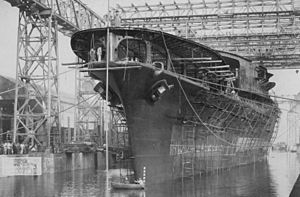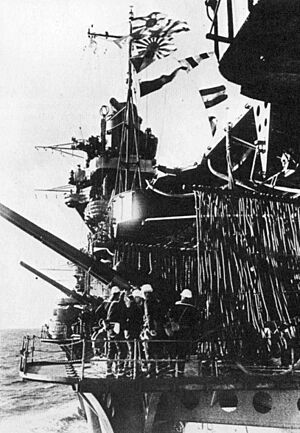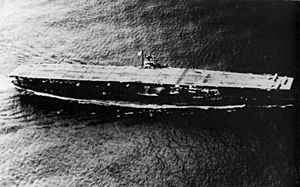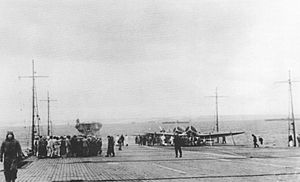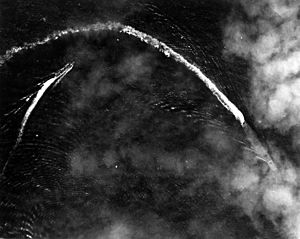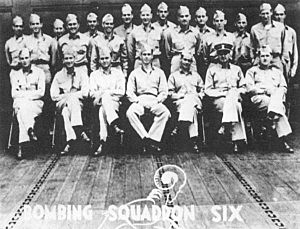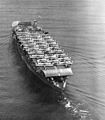Japanese aircraft carrier Akagi facts for kids
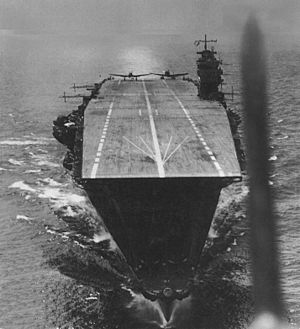
Akagi conducting flight operations, April 1942
|
|
Quick facts for kids Class overview |
|
|---|---|
| Operators: | |
| Preceded by: | Hōshō |
| Succeeded by: | Kaga |
| Built: | 1920–1927 |
| In service: | 1927–1942 |
| In commission: | 1927–1942 |
| Completed: | 1 |
| Lost: | 1 |
| History | |
| Name | Akagi |
| Namesake | Mount Akagi |
| Ordered | 1920 |
| Builder | Kure Naval Arsenal |
| Cost | ¥53 million ($36.45 million) |
| Laid down | 6 December 1920 |
| Launched | 22 April 1925 |
| Commissioned | 25 March 1927 |
| Reclassified | 21 November 1923 as an aircraft carrier |
| Refit | 24 October 1935 – 31 August 1938 |
| Stricken | 25 September 1942 |
| Fate | Damaged by aircraft during the Battle of Midway and scuttled, 5 June 1942 |
| General characteristics (after 1938 modernization) | |
| Class and type | None |
| Type | Aircraft carrier |
| Displacement | |
| Length | 260.67 m (855 ft 3 in) |
| Beam | 31.32 m (102 ft 9 in) |
| Draught | 8.71 m (28 ft 7 in) |
| Installed power |
|
| Propulsion | 4 shafts; 4 geared steam turbines |
| Speed | 31.5 knots (58.3 km/h; 36.2 mph) |
| Range | 10,000 nmi (19,000 km; 12,000 mi) at 16 knots (30 km/h; 18 mph) |
| Complement | 1,630 |
| Armament |
|
| Armor |
|
| Aircraft carried |
|
| Service record | |
| Part of: | First Air Fleet (Kido Butai) |
| Commanders: |
|
| Operations: |
|
The Akagi (meaning "red castle" in Japanese) was a famous aircraft carrier of the Imperial Japanese Navy (IJN). It was named after Mount Akagi, a volcano in Japan.
Originally, Akagi was planned to be a powerful warship called a battlecruiser. However, due to an agreement called the Washington Naval Treaty in 1922, Japan had to limit the number of large warships it built. So, while still being built, Akagi was changed into an aircraft carrier.
Akagi was the second aircraft carrier to join the Japanese Navy and the first really big one. Along with another carrier, Kaga, Akagi played a key role in developing Japan's new strategy for using aircraft carriers. This strategy involved grouping carriers together to focus their air power. This new approach helped Japan achieve its goals early in the Pacific War (part of World War II) from late 1941 to mid-1942.
Akagi's planes were used in the Second Sino-Japanese War in the late 1930s. In 1941, she became the flagship (the ship where the commander stays) of the First Air Fleet, also known as the Kido Butai (Striking Force). She remained the flagship throughout her service.
With other carriers, Akagi took part in the surprise Attack on Pearl Harbor in December 1941. Her planes also helped invade Rabaul in January 1942. The next month, her aircraft bombed Darwin, Australia, and helped conquer the Dutch East Indies. In March and April 1942, Akagi's planes helped sink British and Australian warships during the Indian Ocean raid.
After a quick repair, Akagi and three other carriers of the Kido Butai fought in the Battle of Midway in June 1942. After attacking American forces on Midway Atoll, Akagi and the other carriers were attacked by American planes. Dive bombers from the American carrier Enterprise badly damaged Akagi. When it was clear she couldn't be saved, Japanese destroyers sank her to prevent her from being captured. Losing Akagi and three other Japanese carriers at Midway was a major defeat for Japan and helped the Allies win the war in the Pacific. Her wreck was found in October 2019.
Contents
Building the Akagi
From Battlecruiser to Carrier
Akagi was started as a battlecruiser at Kure Naval Arsenal in Japan on December 6, 1920. However, construction stopped in February 1922 when Japan signed the Washington Naval Treaty. This treaty limited how many battleships and battlecruisers countries could build. It did allow two battlecruiser hulls to be turned into aircraft carriers.
The Japanese Navy wanted two large, fast carriers. So, the unfinished hulls of Akagi and another ship, Amagi, were chosen to become carriers. Amagi's hull was too damaged by the 1923 Great Kantō earthquake to be used. So, Akagi became the only ship from her class to be completed.
Building Akagi as an aircraft carrier began on November 19, 1923. She was launched on April 22, 1925, and officially joined the navy on March 25, 1927. She was the second carrier to join the Japanese Navy, after the smaller Hōshō.
Flight Decks and Aircraft
When first built, Akagi had three flight decks, which was very unusual. No other carriers were designed this way. The main flight deck was on top, and two shorter ones were below it. The idea was to allow planes to take off and land at the same time. However, the lower decks were so short that only very light planes could use them.
The ship had two main hangar decks and a third smaller one for storing planes. Aircraft were moved between the hangars and flight decks using two lifts. Akagi did not have catapults to help launch planes.
Initially, Akagi carried 60 aircraft. These included torpedo bombers, Nakajima A1N fighters, and Mitsubishi 2MR reconnaissance planes.
Weapons and Protection
Akagi was armed with ten large 20 cm (8 in) guns. Six of these were in the back of the ship, and four were in two turrets on the middle flight deck. These guns were meant to protect her if she was attacked by enemy cruisers. However, her large flight deck and hangars made her an easy target in a gunfight.
She also had six twin 12 cm (4.7 in) anti-aircraft (AA) guns to shoot down enemy planes. These guns were placed low on the ship, which limited where they could fire.
Akagi's armor belt was 152 mm (6 in) thick, and her deck armor was 79 mm (3.1 in) thick. This armor was less than what was planned when she was a battlecruiser.
Engines and Speed
Akagi had four steam turbines that powered her propellers, giving her a total of 131,000 horsepower. Steam came from 19 boilers. Some boilers used oil, and others used a mix of oil and coal.
She could reach a top speed of 32.5 knots (60.2 km/h; 37.4 mph). She could travel about 8,000 nautical miles (15,000 km; 9,200 mi) at a speed of 14 knots (26 km/h; 16 mph).
Early Years of Service
Akagi joined the Japanese fleet in August 1927. Her early years were spent doing training exercises. From 1928 to 1929, she was captained by Isoroku Yamamoto, who would later become a very important commander in the war.
At this time, the Japanese Navy was still figuring out how best to use aircraft carriers. At first, carriers were seen as support ships for battleships. Their planes would attack enemy battleships. Later, attacking enemy carriers to gain control of the sky became just as important. This new idea meant Japanese carrier planes needed to strike first with a large, surprise attack.
To do this, carriers needed longer flight decks for bigger, heavier planes. Because of this, Akagi was taken out of service in November 1935 for a major upgrade.
Major Reconstruction
Akagi underwent a big reconstruction that lasted until August 1938. This was done because her three flight decks were too small for the newer, larger aircraft.
- New Flight Deck: The middle and lower flight decks were removed. Instead, a single, much longer flight deck was built, extending almost the entire length of the ship. This increased her aircraft capacity to 86 planes (61 ready for use and 25 in storage).
- Hangars: Two enclosed hangar decks were built, also running almost the full length of the ship.
- Elevator: A third aircraft lift was added in the middle of the ship.
- Island: An island superstructure (the control tower) was added on the port (left) side of the ship. This was unusual, as most carriers had their island on the starboard (right) side. It was an experiment to see if the left side was better for flight operations.
- Engines: Her boilers were updated to use only oil, and her ventilation was improved. Her speed remained good, around 31.2 knots.
- Weapons: The two large gun turrets on the old middle flight deck were removed. Instead, 14 twin 25 mm anti-aircraft guns were added. These guns fired quickly but were placed low on the hull, which limited their firing range.
Despite these upgrades, Akagi still had some weaknesses. Her aviation fuel tanks were built directly into the ship's structure, meaning they could easily crack or leak if the ship was hit. Also, the enclosed hangars made it hard to fight fires, especially since Japanese doctrine often meant fueling and arming planes inside the hangars. The flight deck and hangars also had little armor. These problems would later prove very dangerous.
Leading up to World War II
Akagi's reconstruction finished in August 1938. Her experiences in China helped the Japanese Navy improve its carrier strategy. They learned that grouping many naval aircraft together was very powerful.
In April 1941, the Japanese Navy formed the First Air Fleet, or Kido Butai. This group brought all their fleet carriers under one command. Akagi became the flagship of this new fleet. The Japanese strategy was to combine the aircraft from all carriers in a division for massive air attacks.
While this concentration of carriers was a new and powerful idea, the First Air Fleet had weaknesses in defense. Their anti-aircraft guns were not very effective, and they had too few fighter planes for defense. They also lacked good radar and communication with their fighters. These problems, combined with Akagi's design flaws, would later lead to her downfall.
World War II Battles
Pearl Harbor and Beyond
In November 1941, Akagi joined the rest of the First Air Fleet in the Kuril Islands. On November 26, 1941, the ships set sail for Hawaii.
On December 7, 1941, Akagi, as Vice Admiral Chūichi Nagumo's flagship, launched two waves of aircraft for the Attack on Pearl Harbor.
- First Wave: 27 Nakajima B5N "Kate" torpedo bombers from Akagi attacked battleships like Oklahoma. Nine of her Mitsubishi A6M Zero fighters attacked Hickam Field.
- Second Wave: 18 Aichi D3A "Val" dive bombers from Akagi targeted battleships like Maryland. Nine "Zeros" attacked other airfields.
One of Akagi's Zero fighters was shot down during the attack.
In January 1942, Akagi helped invade Rabaul in the Bismarck Archipelago. Her planes attacked Rabaul and Kavieng. In February, her aircraft bombed Darwin, Australia, sinking several ships and damaging others. This helped the Japanese in their invasion of Java. On March 1, Akagi's planes helped sink the American oiler Pecos and the destroyer Edsall.
Indian Ocean Raid

On March 26, Akagi sailed with the Kido Butai for the Indian Ocean raid. The goal was to defeat the British fleet and air power in the area.
- April 5: Akagi launched 17 B5Ns and 9 Zeros to attack Colombo, Ceylon. They damaged port facilities and shot down British fighters. Later, 17 D3As from Akagi helped sink the British heavy cruisers Cornwall and Dorsetshire.
- April 9: Akagi attacked Trincomalee with 18 B5Ns and 6 Zeros. Her planes also helped sink the small aircraft carrier Hermes and the Australian destroyer Vampire.
After this raid, the fleet returned to Japan for repairs and supplies. On April 19, Akagi was sent to chase American carriers that had launched the Doolittle Raid, but found nothing.
Battle of Midway
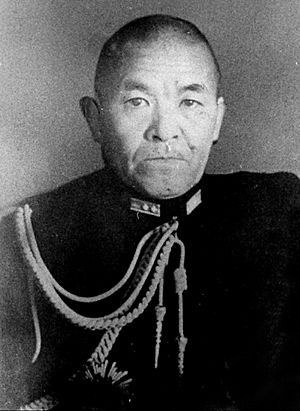
Japan's Admiral Yamamoto wanted to destroy the American carrier threat. He decided to invade Midway Atoll, believing it would force the US Navy into a major battle.
On May 25, 1942, Akagi sailed with the carriers Kaga, Hiryū, and Sōryū for the attack on Midway. Admiral Nagumo was again on Akagi. Her aircraft included 24 Zeros, 18 D3As, and 18 B5Ns.
On June 4, 1942, at dawn, Akagi launched 18 dive bombers and 9 Zeros to attack the airfield on Eastern Island at Midway. The carrier's torpedo bombers were kept ready in case enemy ships appeared. Unknown to the Japanese, the US Navy had broken their secret codes and set up an ambush with three carriers northeast of Midway.
At 07:10, American planes from Midway Island attacked the Japanese carriers. Akagi's fighters helped defend the fleet. American torpedo planes and bombers attacked Akagi, but her fighters and evasive maneuvers helped her avoid serious damage at first. One B-26 bomber even came very close to crashing into Akagi's bridge.
Nagumo first ordered his torpedo bombers rearmed with bombs for another attack on Midway. But then, a scout plane reported American warships. Nagumo quickly changed his order, telling his crews to rearm the planes with torpedoes for an attack on the American ships. This process was slow and difficult.
Akagi is Sunk
Around 07:55, more American planes from Midway attacked, but Akagi's fighters shot down many of them. High-altitude bombers also attacked Akagi, but she managed to avoid their bombs.
Akagi continued to launch fighters to defend the fleet. Around 09:18, the first American carrier planes arrived. These were torpedo bombers from the carrier Hornet. Akagi's fighters, along with others, shot down all 15 of these planes. Shortly after, more torpedo bombers from the carrier Enterprise attacked. Again, Japanese fighters shot down most of them.
Minutes after the torpedo plane attacks, American dive bombers arrived almost unseen. Around 10:20, their attack began. Twenty-eight dive bombers from Enterprise attacked Kaga. At the last moment, three bombers, led by squadron commander Richard Best, broke off and dove on Akagi.
At about 10:26, the three bombers hit Akagi with one 1,000-pound bomb and narrowly missed with two others. The bomb hit the middle elevator and exploded in the upper hangar. This set off explosions among the fully armed and fueled torpedo bombers waiting there. A massive, uncontrollable fire started.
Admiral Nagumo ordered the ship's magazines (where ammunition was stored) to be flooded to prevent more explosions. The front magazines were flooded, but the back ones could not be due to damage. The ship's main water pump was also damaged, making it very hard to fight the fires. The burning aviation fuel spread quickly.
By 10:46, the fires made the ship's bridge unusable. Nagumo had to move his flag to the light cruiser Nagara. Akagi stopped moving at 13:50, and most of her crew were evacuated. She continued to burn throughout the night.
At 04:50 on June 5, Admiral Yamamoto ordered Akagi to be sunk. He said, "I was once the captain of Akagi, and it is with heartfelt regret that I must now order that she be sunk." Japanese destroyers fired torpedoes into the carrier, and she sank, bow first, at 05:20.
Two hundred and sixty-seven of Akagi's crew were lost. The loss of Akagi and three other Japanese carriers at Midway was a huge defeat for Japan. It greatly contributed to Japan's eventual loss in the war. To hide the defeat, Akagi was not immediately removed from the Navy's list of ships.
Finding the Wreck
On October 20, 2019, the wreck of Akagi was found by the Research Vessel Petrel. It was located about 1,300 miles (2,100 km) northwest of Pearl Harbor, at a depth of 18,011 feet (5,490 m). The wreck is upright and mostly intact. Two days before finding Akagi, the Petrel had also found the wreck of Kaga.
Images for kids
See also
 In Spanish: Akagi (1927) para niños
In Spanish: Akagi (1927) para niños


